Corporate Accounting Report: Equity, Liabilities, and Company Types
VerifiedAdded on 2022/12/27
|16
|3944
|78
Report
AI Summary
This report delves into the realm of corporate accounting, providing a comprehensive analysis of equity and liabilities within the context of two prominent ASX-listed companies, BHP Billiton and Rio Tinto. The report meticulously examines the items recorded under the owner's equity and liabilities sections of their financial statements, detailing the movements within each item over specific periods. Furthermore, it explores the relative advantages and disadvantages of different funding sources employed by these companies. The report extends its scope to encompass the classification of companies, differentiating between small proprietary companies, large proprietary companies, and reporting entities, and elucidates the implications of these classifications in terms of reporting and compliance requirements. The analysis covers changes in equity attributable to shareholders, non-controlling interests, and various components of liabilities, offering a nuanced understanding of financial performance and position.
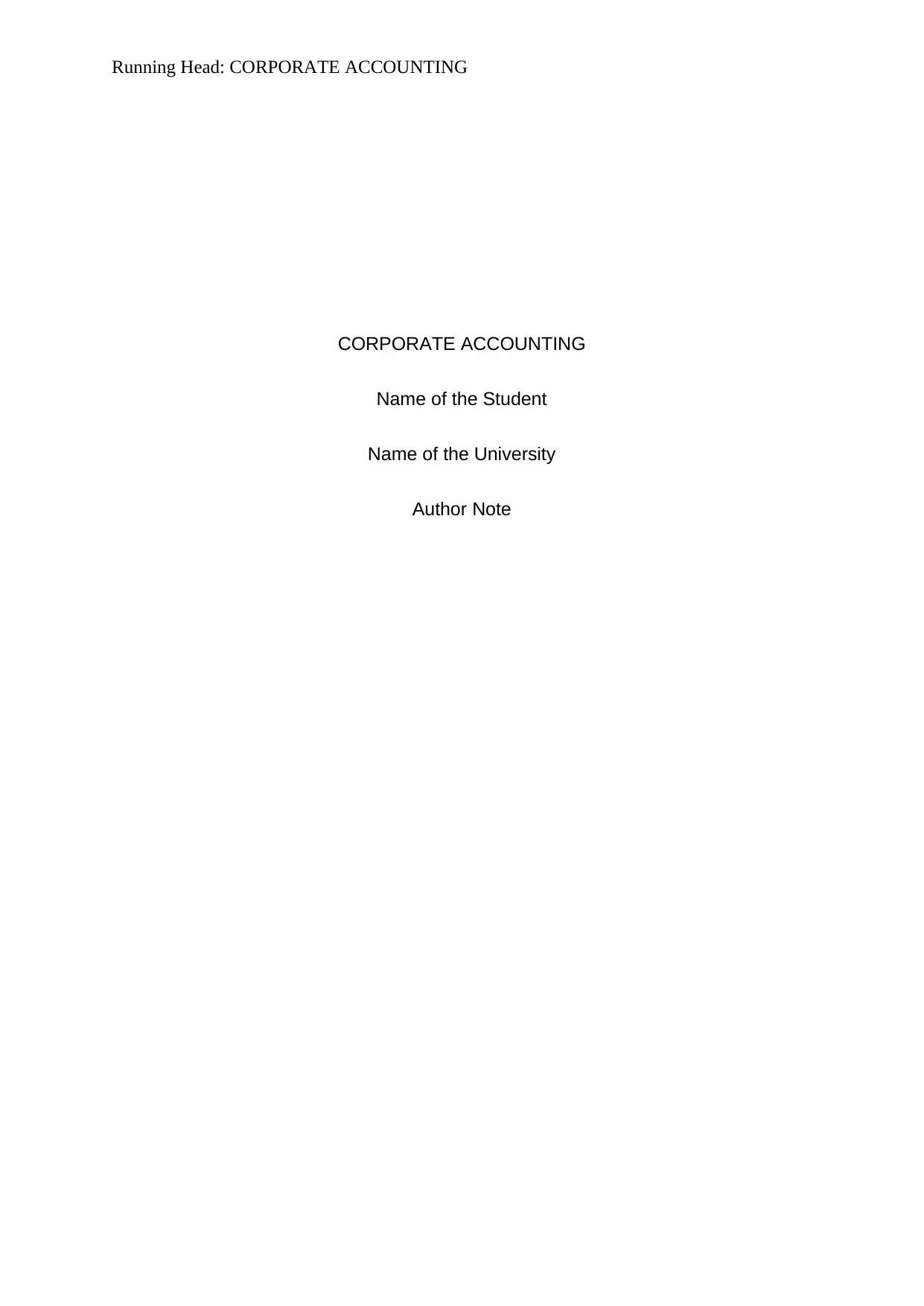
Running Head: CORPORATE ACCOUNTING
CORPORATE ACCOUNTING
Name of the Student
Name of the University
Author Note
CORPORATE ACCOUNTING
Name of the Student
Name of the University
Author Note
Paraphrase This Document
Need a fresh take? Get an instant paraphrase of this document with our AI Paraphraser
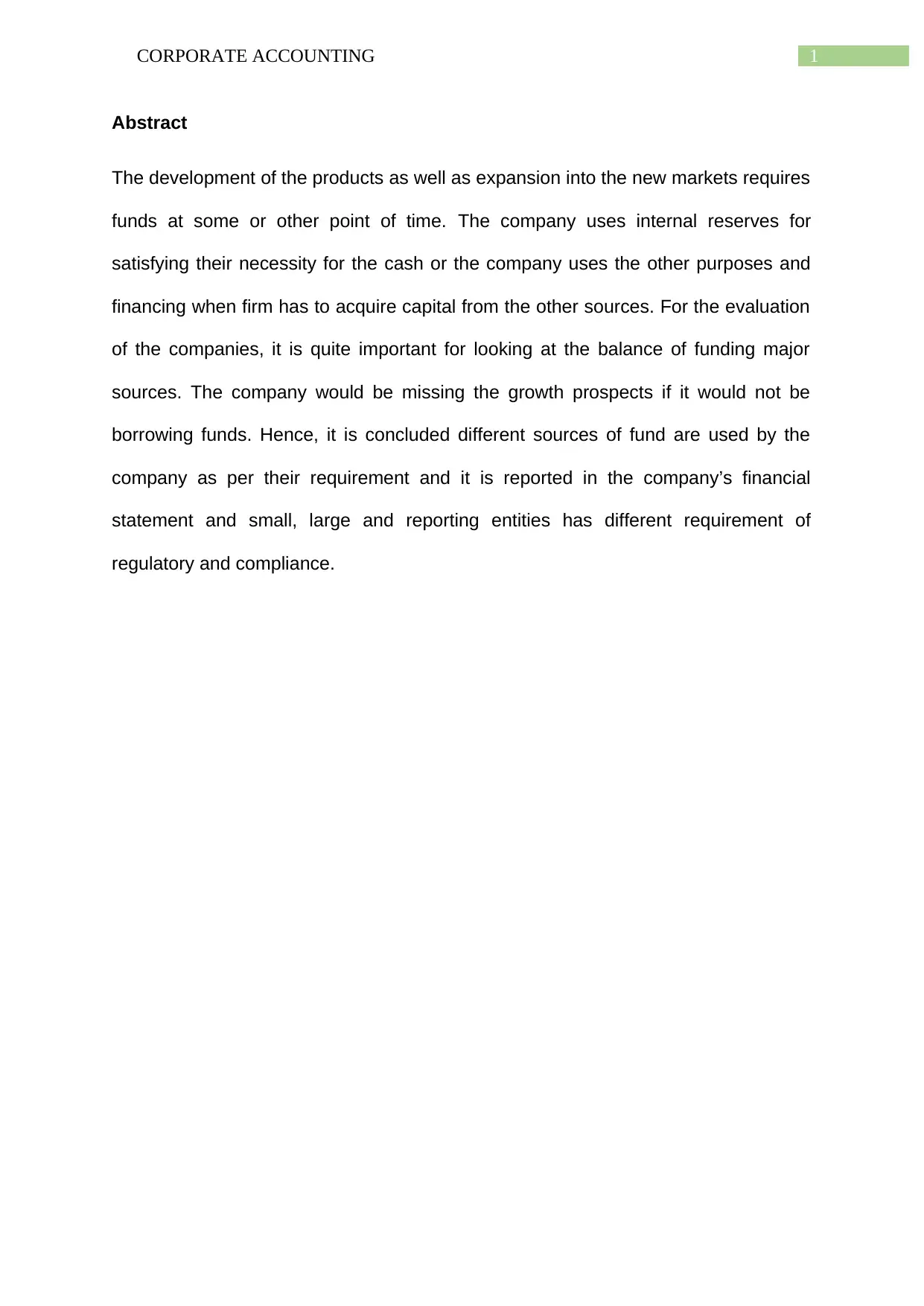
1CORPORATE ACCOUNTING
Abstract
The development of the products as well as expansion into the new markets requires
funds at some or other point of time. The company uses internal reserves for
satisfying their necessity for the cash or the company uses the other purposes and
financing when firm has to acquire capital from the other sources. For the evaluation
of the companies, it is quite important for looking at the balance of funding major
sources. The company would be missing the growth prospects if it would not be
borrowing funds. Hence, it is concluded different sources of fund are used by the
company as per their requirement and it is reported in the company’s financial
statement and small, large and reporting entities has different requirement of
regulatory and compliance.
Abstract
The development of the products as well as expansion into the new markets requires
funds at some or other point of time. The company uses internal reserves for
satisfying their necessity for the cash or the company uses the other purposes and
financing when firm has to acquire capital from the other sources. For the evaluation
of the companies, it is quite important for looking at the balance of funding major
sources. The company would be missing the growth prospects if it would not be
borrowing funds. Hence, it is concluded different sources of fund are used by the
company as per their requirement and it is reported in the company’s financial
statement and small, large and reporting entities has different requirement of
regulatory and compliance.
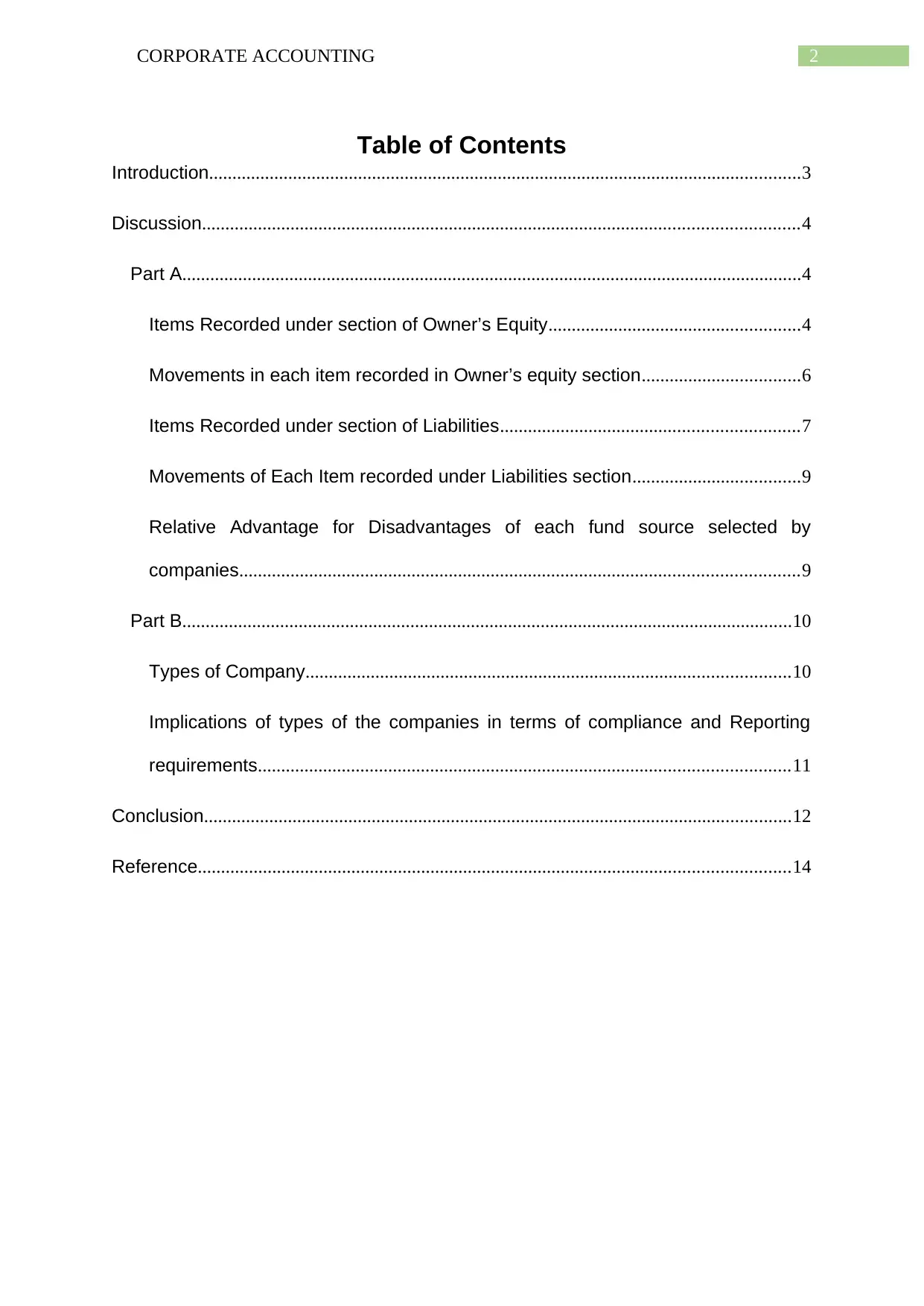
2CORPORATE ACCOUNTING
Table of Contents
Introduction...............................................................................................................................3
Discussion................................................................................................................................4
Part A.....................................................................................................................................4
Items Recorded under section of Owner’s Equity......................................................4
Movements in each item recorded in Owner’s equity section..................................6
Items Recorded under section of Liabilities................................................................7
Movements of Each Item recorded under Liabilities section....................................9
Relative Advantage for Disadvantages of each fund source selected by
companies........................................................................................................................9
Part B...................................................................................................................................10
Types of Company........................................................................................................10
Implications of types of the companies in terms of compliance and Reporting
requirements..................................................................................................................11
Conclusion..............................................................................................................................12
Reference...............................................................................................................................14
Table of Contents
Introduction...............................................................................................................................3
Discussion................................................................................................................................4
Part A.....................................................................................................................................4
Items Recorded under section of Owner’s Equity......................................................4
Movements in each item recorded in Owner’s equity section..................................6
Items Recorded under section of Liabilities................................................................7
Movements of Each Item recorded under Liabilities section....................................9
Relative Advantage for Disadvantages of each fund source selected by
companies........................................................................................................................9
Part B...................................................................................................................................10
Types of Company........................................................................................................10
Implications of types of the companies in terms of compliance and Reporting
requirements..................................................................................................................11
Conclusion..............................................................................................................................12
Reference...............................................................................................................................14
⊘ This is a preview!⊘
Do you want full access?
Subscribe today to unlock all pages.

Trusted by 1+ million students worldwide
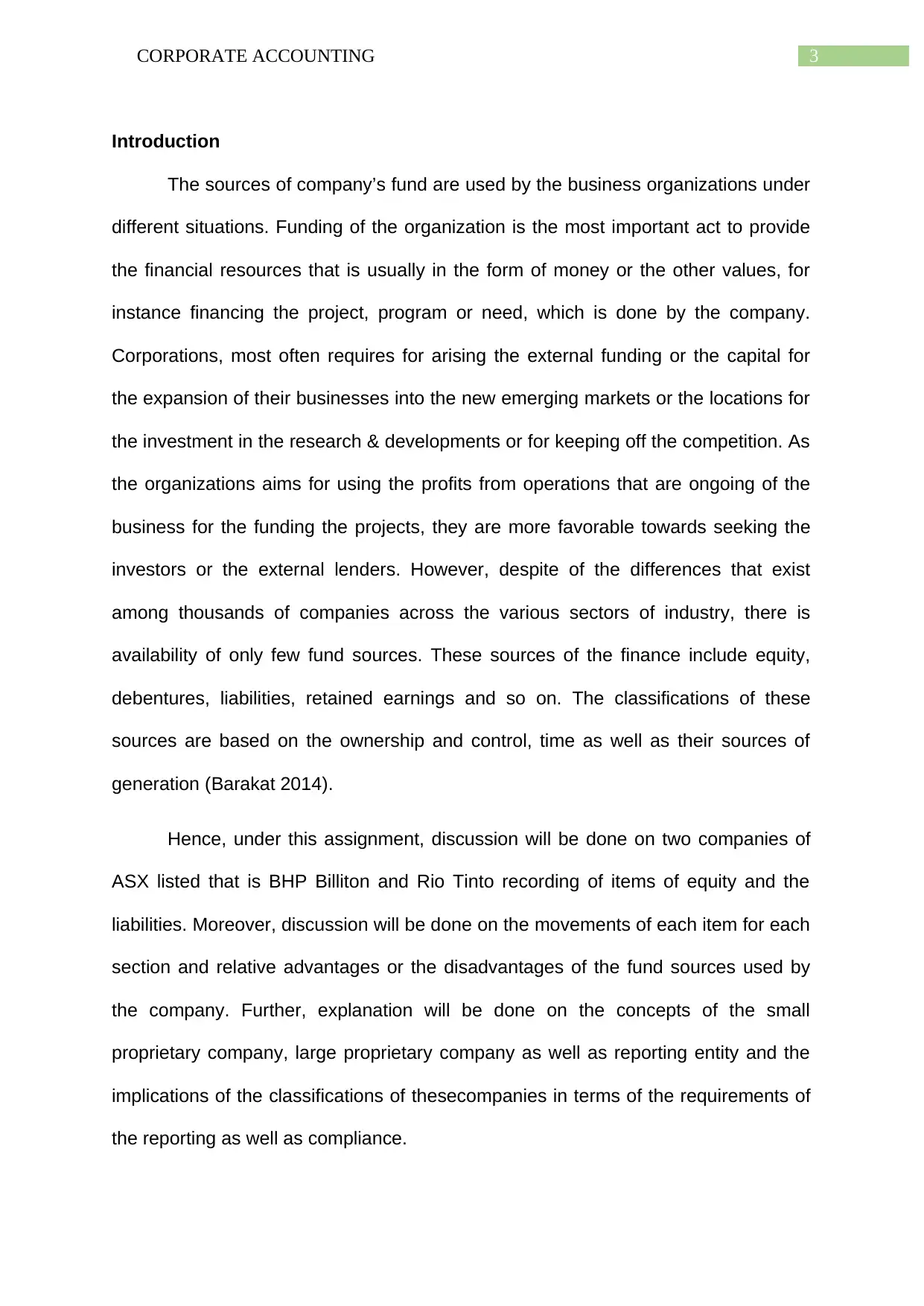
3CORPORATE ACCOUNTING
Introduction
The sources of company’s fund are used by the business organizations under
different situations. Funding of the organization is the most important act to provide
the financial resources that is usually in the form of money or the other values, for
instance financing the project, program or need, which is done by the company.
Corporations, most often requires for arising the external funding or the capital for
the expansion of their businesses into the new emerging markets or the locations for
the investment in the research & developments or for keeping off the competition. As
the organizations aims for using the profits from operations that are ongoing of the
business for the funding the projects, they are more favorable towards seeking the
investors or the external lenders. However, despite of the differences that exist
among thousands of companies across the various sectors of industry, there is
availability of only few fund sources. These sources of the finance include equity,
debentures, liabilities, retained earnings and so on. The classifications of these
sources are based on the ownership and control, time as well as their sources of
generation (Barakat 2014).
Hence, under this assignment, discussion will be done on two companies of
ASX listed that is BHP Billiton and Rio Tinto recording of items of equity and the
liabilities. Moreover, discussion will be done on the movements of each item for each
section and relative advantages or the disadvantages of the fund sources used by
the company. Further, explanation will be done on the concepts of the small
proprietary company, large proprietary company as well as reporting entity and the
implications of the classifications of thesecompanies in terms of the requirements of
the reporting as well as compliance.
Introduction
The sources of company’s fund are used by the business organizations under
different situations. Funding of the organization is the most important act to provide
the financial resources that is usually in the form of money or the other values, for
instance financing the project, program or need, which is done by the company.
Corporations, most often requires for arising the external funding or the capital for
the expansion of their businesses into the new emerging markets or the locations for
the investment in the research & developments or for keeping off the competition. As
the organizations aims for using the profits from operations that are ongoing of the
business for the funding the projects, they are more favorable towards seeking the
investors or the external lenders. However, despite of the differences that exist
among thousands of companies across the various sectors of industry, there is
availability of only few fund sources. These sources of the finance include equity,
debentures, liabilities, retained earnings and so on. The classifications of these
sources are based on the ownership and control, time as well as their sources of
generation (Barakat 2014).
Hence, under this assignment, discussion will be done on two companies of
ASX listed that is BHP Billiton and Rio Tinto recording of items of equity and the
liabilities. Moreover, discussion will be done on the movements of each item for each
section and relative advantages or the disadvantages of the fund sources used by
the company. Further, explanation will be done on the concepts of the small
proprietary company, large proprietary company as well as reporting entity and the
implications of the classifications of thesecompanies in terms of the requirements of
the reporting as well as compliance.
Paraphrase This Document
Need a fresh take? Get an instant paraphrase of this document with our AI Paraphraser
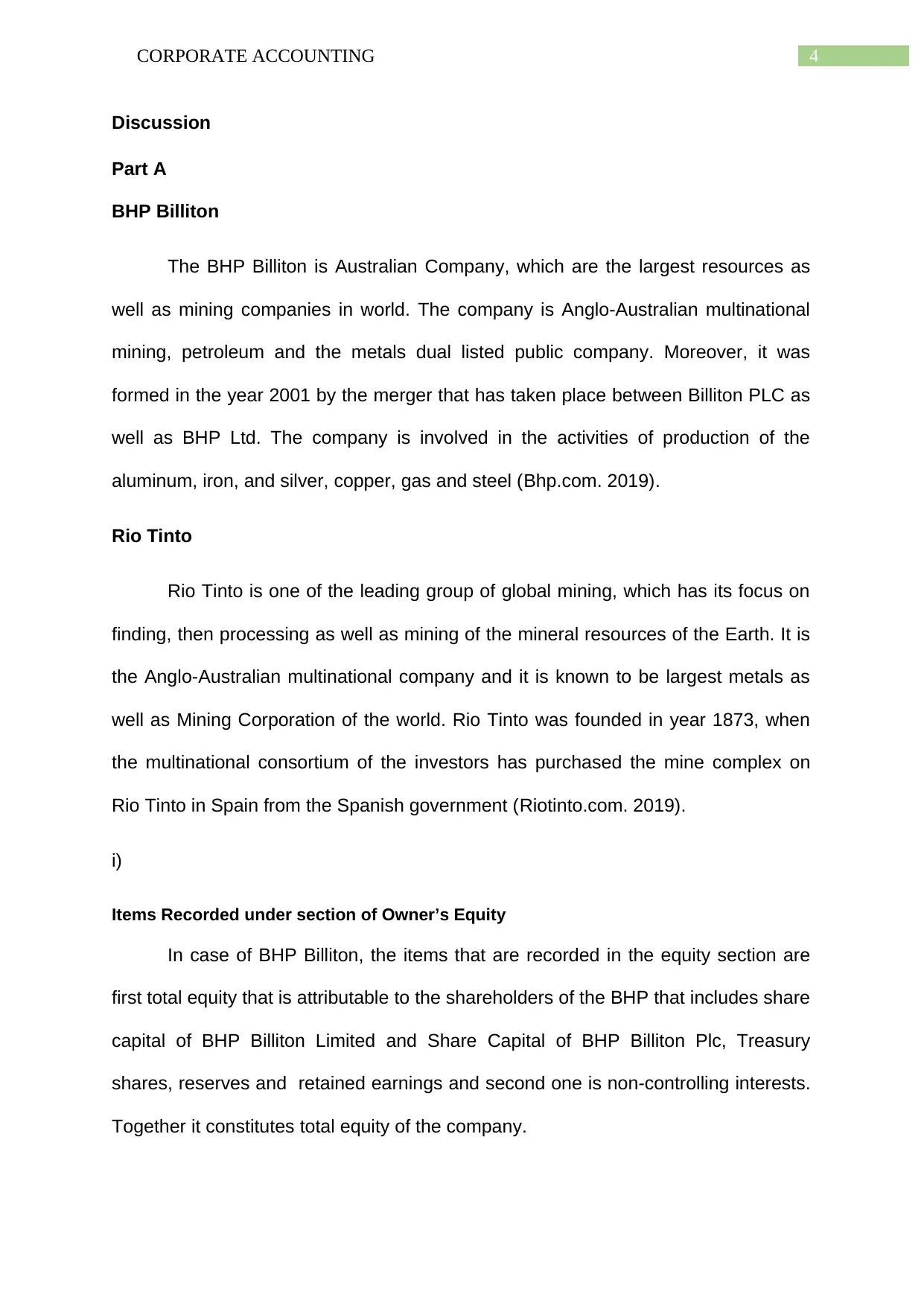
4CORPORATE ACCOUNTING
Discussion
Part A
BHP Billiton
The BHP Billiton is Australian Company, which are the largest resources as
well as mining companies in world. The company is Anglo-Australian multinational
mining, petroleum and the metals dual listed public company. Moreover, it was
formed in the year 2001 by the merger that has taken place between Billiton PLC as
well as BHP Ltd. The company is involved in the activities of production of the
aluminum, iron, and silver, copper, gas and steel (Bhp.com. 2019).
Rio Tinto
Rio Tinto is one of the leading group of global mining, which has its focus on
finding, then processing as well as mining of the mineral resources of the Earth. It is
the Anglo-Australian multinational company and it is known to be largest metals as
well as Mining Corporation of the world. Rio Tinto was founded in year 1873, when
the multinational consortium of the investors has purchased the mine complex on
Rio Tinto in Spain from the Spanish government (Riotinto.com. 2019).
i)
Items Recorded under section of Owner’s Equity
In case of BHP Billiton, the items that are recorded in the equity section are
first total equity that is attributable to the shareholders of the BHP that includes share
capital of BHP Billiton Limited and Share Capital of BHP Billiton Plc, Treasury
shares, reserves and retained earnings and second one is non-controlling interests.
Together it constitutes total equity of the company.
Discussion
Part A
BHP Billiton
The BHP Billiton is Australian Company, which are the largest resources as
well as mining companies in world. The company is Anglo-Australian multinational
mining, petroleum and the metals dual listed public company. Moreover, it was
formed in the year 2001 by the merger that has taken place between Billiton PLC as
well as BHP Ltd. The company is involved in the activities of production of the
aluminum, iron, and silver, copper, gas and steel (Bhp.com. 2019).
Rio Tinto
Rio Tinto is one of the leading group of global mining, which has its focus on
finding, then processing as well as mining of the mineral resources of the Earth. It is
the Anglo-Australian multinational company and it is known to be largest metals as
well as Mining Corporation of the world. Rio Tinto was founded in year 1873, when
the multinational consortium of the investors has purchased the mine complex on
Rio Tinto in Spain from the Spanish government (Riotinto.com. 2019).
i)
Items Recorded under section of Owner’s Equity
In case of BHP Billiton, the items that are recorded in the equity section are
first total equity that is attributable to the shareholders of the BHP that includes share
capital of BHP Billiton Limited and Share Capital of BHP Billiton Plc, Treasury
shares, reserves and retained earnings and second one is non-controlling interests.
Together it constitutes total equity of the company.
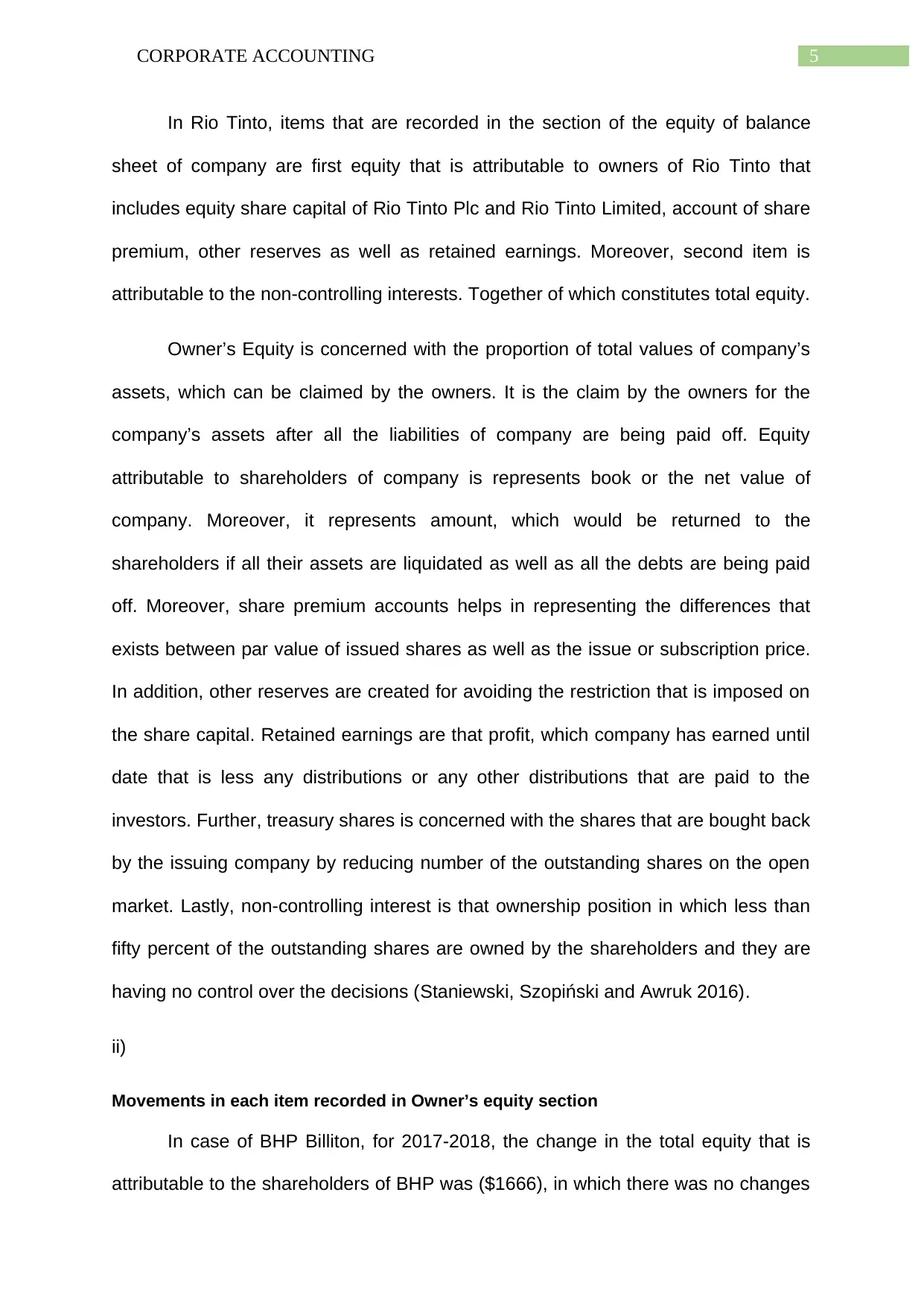
5CORPORATE ACCOUNTING
In Rio Tinto, items that are recorded in the section of the equity of balance
sheet of company are first equity that is attributable to owners of Rio Tinto that
includes equity share capital of Rio Tinto Plc and Rio Tinto Limited, account of share
premium, other reserves as well as retained earnings. Moreover, second item is
attributable to the non-controlling interests. Together of which constitutes total equity.
Owner’s Equity is concerned with the proportion of total values of company’s
assets, which can be claimed by the owners. It is the claim by the owners for the
company’s assets after all the liabilities of company are being paid off. Equity
attributable to shareholders of company is represents book or the net value of
company. Moreover, it represents amount, which would be returned to the
shareholders if all their assets are liquidated as well as all the debts are being paid
off. Moreover, share premium accounts helps in representing the differences that
exists between par value of issued shares as well as the issue or subscription price.
In addition, other reserves are created for avoiding the restriction that is imposed on
the share capital. Retained earnings are that profit, which company has earned until
date that is less any distributions or any other distributions that are paid to the
investors. Further, treasury shares is concerned with the shares that are bought back
by the issuing company by reducing number of the outstanding shares on the open
market. Lastly, non-controlling interest is that ownership position in which less than
fifty percent of the outstanding shares are owned by the shareholders and they are
having no control over the decisions (Staniewski, Szopiński and Awruk 2016).
ii)
Movements in each item recorded in Owner’s equity section
In case of BHP Billiton, for 2017-2018, the change in the total equity that is
attributable to the shareholders of BHP was ($1666), in which there was no changes
In Rio Tinto, items that are recorded in the section of the equity of balance
sheet of company are first equity that is attributable to owners of Rio Tinto that
includes equity share capital of Rio Tinto Plc and Rio Tinto Limited, account of share
premium, other reserves as well as retained earnings. Moreover, second item is
attributable to the non-controlling interests. Together of which constitutes total equity.
Owner’s Equity is concerned with the proportion of total values of company’s
assets, which can be claimed by the owners. It is the claim by the owners for the
company’s assets after all the liabilities of company are being paid off. Equity
attributable to shareholders of company is represents book or the net value of
company. Moreover, it represents amount, which would be returned to the
shareholders if all their assets are liquidated as well as all the debts are being paid
off. Moreover, share premium accounts helps in representing the differences that
exists between par value of issued shares as well as the issue or subscription price.
In addition, other reserves are created for avoiding the restriction that is imposed on
the share capital. Retained earnings are that profit, which company has earned until
date that is less any distributions or any other distributions that are paid to the
investors. Further, treasury shares is concerned with the shares that are bought back
by the issuing company by reducing number of the outstanding shares on the open
market. Lastly, non-controlling interest is that ownership position in which less than
fifty percent of the outstanding shares are owned by the shareholders and they are
having no control over the decisions (Staniewski, Szopiński and Awruk 2016).
ii)
Movements in each item recorded in Owner’s equity section
In case of BHP Billiton, for 2017-2018, the change in the total equity that is
attributable to the shareholders of BHP was ($1666), in which there was no changes
⊘ This is a preview!⊘
Do you want full access?
Subscribe today to unlock all pages.

Trusted by 1+ million students worldwide
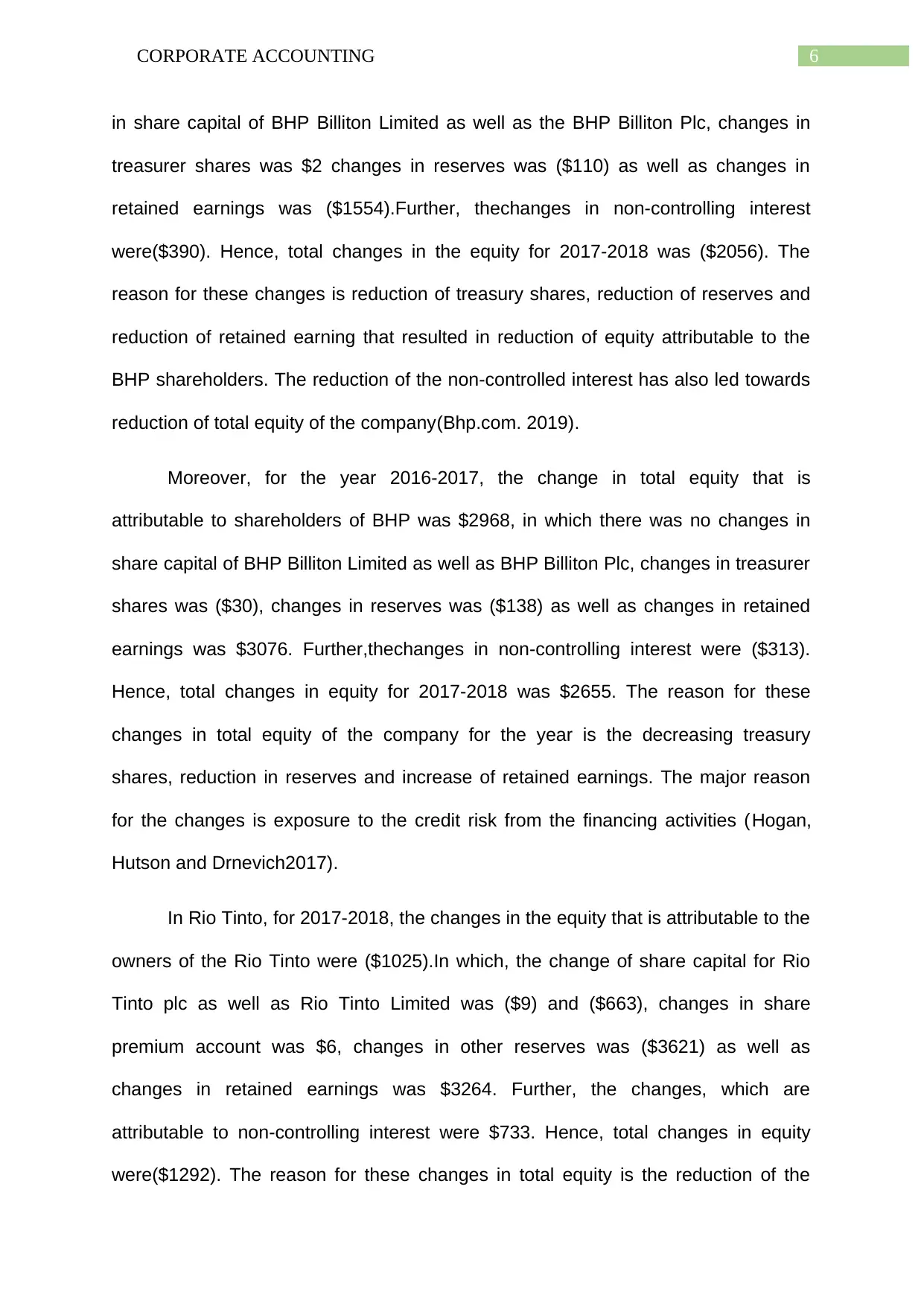
6CORPORATE ACCOUNTING
in share capital of BHP Billiton Limited as well as the BHP Billiton Plc, changes in
treasurer shares was $2 changes in reserves was ($110) as well as changes in
retained earnings was ($1554).Further, thechanges in non-controlling interest
were($390). Hence, total changes in the equity for 2017-2018 was ($2056). The
reason for these changes is reduction of treasury shares, reduction of reserves and
reduction of retained earning that resulted in reduction of equity attributable to the
BHP shareholders. The reduction of the non-controlled interest has also led towards
reduction of total equity of the company(Bhp.com. 2019).
Moreover, for the year 2016-2017, the change in total equity that is
attributable to shareholders of BHP was $2968, in which there was no changes in
share capital of BHP Billiton Limited as well as BHP Billiton Plc, changes in treasurer
shares was ($30), changes in reserves was ($138) as well as changes in retained
earnings was $3076. Further,thechanges in non-controlling interest were ($313).
Hence, total changes in equity for 2017-2018 was $2655. The reason for these
changes in total equity of the company for the year is the decreasing treasury
shares, reduction in reserves and increase of retained earnings. The major reason
for the changes is exposure to the credit risk from the financing activities (Hogan,
Hutson and Drnevich2017).
In Rio Tinto, for 2017-2018, the changes in the equity that is attributable to the
owners of the Rio Tinto were ($1025).In which, the change of share capital for Rio
Tinto plc as well as Rio Tinto Limited was ($9) and ($663), changes in share
premium account was $6, changes in other reserves was ($3621) as well as
changes in retained earnings was $3264. Further, the changes, which are
attributable to non-controlling interest were $733. Hence, total changes in equity
were($1292). The reason for these changes in total equity is the reduction of the
in share capital of BHP Billiton Limited as well as the BHP Billiton Plc, changes in
treasurer shares was $2 changes in reserves was ($110) as well as changes in
retained earnings was ($1554).Further, thechanges in non-controlling interest
were($390). Hence, total changes in the equity for 2017-2018 was ($2056). The
reason for these changes is reduction of treasury shares, reduction of reserves and
reduction of retained earning that resulted in reduction of equity attributable to the
BHP shareholders. The reduction of the non-controlled interest has also led towards
reduction of total equity of the company(Bhp.com. 2019).
Moreover, for the year 2016-2017, the change in total equity that is
attributable to shareholders of BHP was $2968, in which there was no changes in
share capital of BHP Billiton Limited as well as BHP Billiton Plc, changes in treasurer
shares was ($30), changes in reserves was ($138) as well as changes in retained
earnings was $3076. Further,thechanges in non-controlling interest were ($313).
Hence, total changes in equity for 2017-2018 was $2655. The reason for these
changes in total equity of the company for the year is the decreasing treasury
shares, reduction in reserves and increase of retained earnings. The major reason
for the changes is exposure to the credit risk from the financing activities (Hogan,
Hutson and Drnevich2017).
In Rio Tinto, for 2017-2018, the changes in the equity that is attributable to the
owners of the Rio Tinto were ($1025).In which, the change of share capital for Rio
Tinto plc as well as Rio Tinto Limited was ($9) and ($663), changes in share
premium account was $6, changes in other reserves was ($3621) as well as
changes in retained earnings was $3264. Further, the changes, which are
attributable to non-controlling interest were $733. Hence, total changes in equity
were($1292). The reason for these changes in total equity is the reduction of the
Paraphrase This Document
Need a fresh take? Get an instant paraphrase of this document with our AI Paraphraser
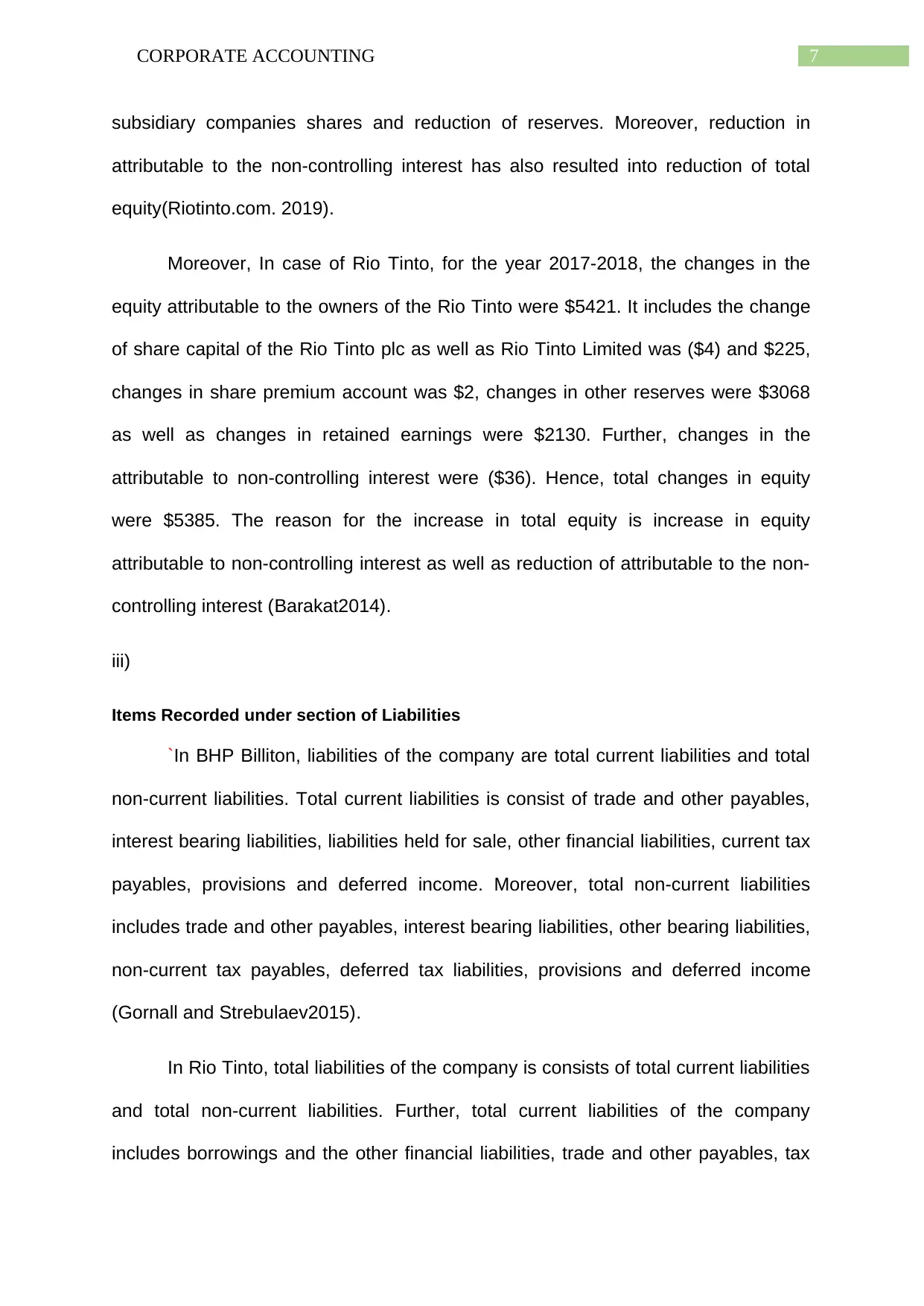
7CORPORATE ACCOUNTING
subsidiary companies shares and reduction of reserves. Moreover, reduction in
attributable to the non-controlling interest has also resulted into reduction of total
equity(Riotinto.com. 2019).
Moreover, In case of Rio Tinto, for the year 2017-2018, the changes in the
equity attributable to the owners of the Rio Tinto were $5421. It includes the change
of share capital of the Rio Tinto plc as well as Rio Tinto Limited was ($4) and $225,
changes in share premium account was $2, changes in other reserves were $3068
as well as changes in retained earnings were $2130. Further, changes in the
attributable to non-controlling interest were ($36). Hence, total changes in equity
were $5385. The reason for the increase in total equity is increase in equity
attributable to non-controlling interest as well as reduction of attributable to the non-
controlling interest (Barakat2014).
iii)
Items Recorded under section of Liabilities
`In BHP Billiton, liabilities of the company are total current liabilities and total
non-current liabilities. Total current liabilities is consist of trade and other payables,
interest bearing liabilities, liabilities held for sale, other financial liabilities, current tax
payables, provisions and deferred income. Moreover, total non-current liabilities
includes trade and other payables, interest bearing liabilities, other bearing liabilities,
non-current tax payables, deferred tax liabilities, provisions and deferred income
(Gornall and Strebulaev2015).
In Rio Tinto, total liabilities of the company is consists of total current liabilities
and total non-current liabilities. Further, total current liabilities of the company
includes borrowings and the other financial liabilities, trade and other payables, tax
subsidiary companies shares and reduction of reserves. Moreover, reduction in
attributable to the non-controlling interest has also resulted into reduction of total
equity(Riotinto.com. 2019).
Moreover, In case of Rio Tinto, for the year 2017-2018, the changes in the
equity attributable to the owners of the Rio Tinto were $5421. It includes the change
of share capital of the Rio Tinto plc as well as Rio Tinto Limited was ($4) and $225,
changes in share premium account was $2, changes in other reserves were $3068
as well as changes in retained earnings were $2130. Further, changes in the
attributable to non-controlling interest were ($36). Hence, total changes in equity
were $5385. The reason for the increase in total equity is increase in equity
attributable to non-controlling interest as well as reduction of attributable to the non-
controlling interest (Barakat2014).
iii)
Items Recorded under section of Liabilities
`In BHP Billiton, liabilities of the company are total current liabilities and total
non-current liabilities. Total current liabilities is consist of trade and other payables,
interest bearing liabilities, liabilities held for sale, other financial liabilities, current tax
payables, provisions and deferred income. Moreover, total non-current liabilities
includes trade and other payables, interest bearing liabilities, other bearing liabilities,
non-current tax payables, deferred tax liabilities, provisions and deferred income
(Gornall and Strebulaev2015).
In Rio Tinto, total liabilities of the company is consists of total current liabilities
and total non-current liabilities. Further, total current liabilities of the company
includes borrowings and the other financial liabilities, trade and other payables, tax
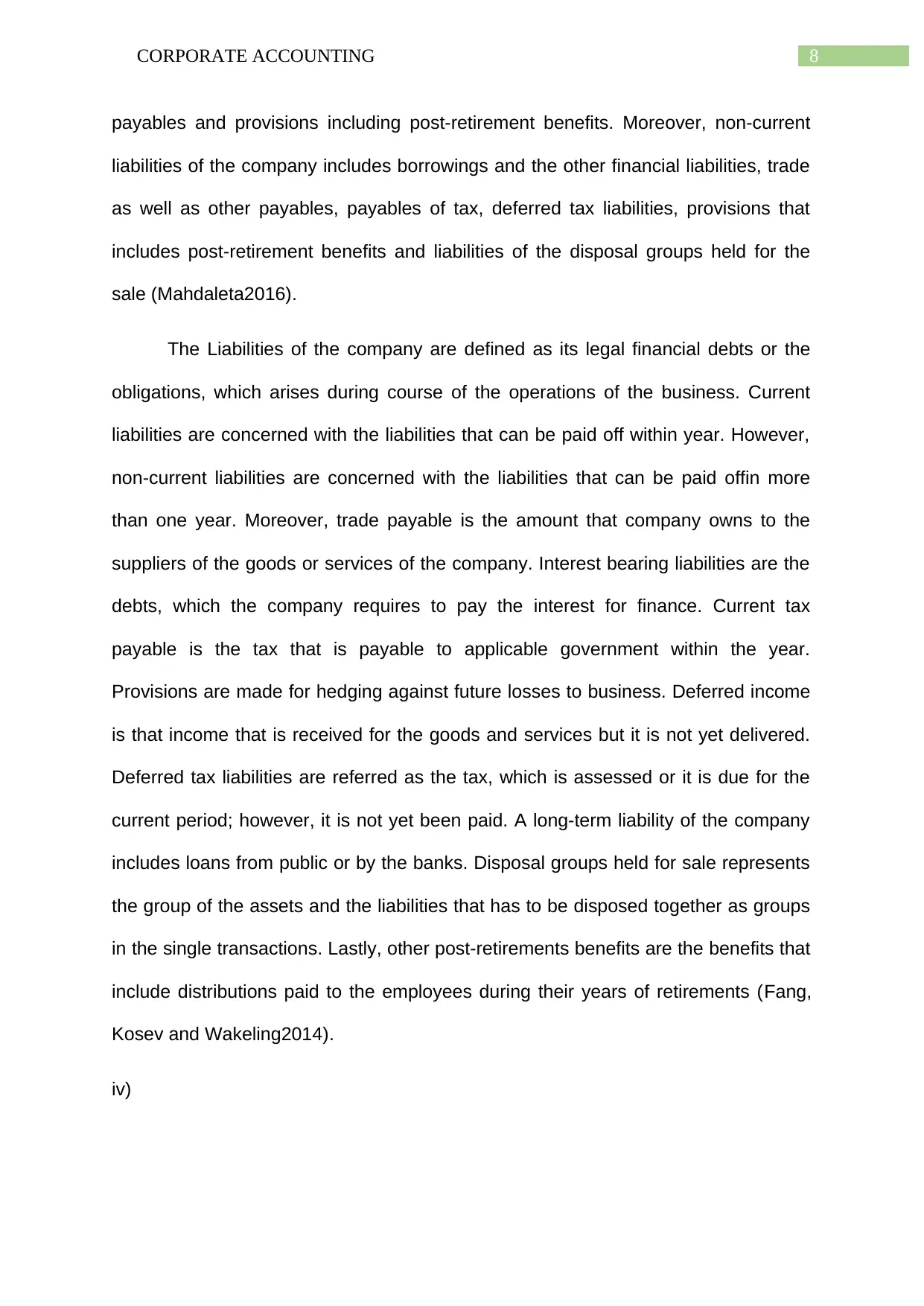
8CORPORATE ACCOUNTING
payables and provisions including post-retirement benefits. Moreover, non-current
liabilities of the company includes borrowings and the other financial liabilities, trade
as well as other payables, payables of tax, deferred tax liabilities, provisions that
includes post-retirement benefits and liabilities of the disposal groups held for the
sale (Mahdaleta2016).
The Liabilities of the company are defined as its legal financial debts or the
obligations, which arises during course of the operations of the business. Current
liabilities are concerned with the liabilities that can be paid off within year. However,
non-current liabilities are concerned with the liabilities that can be paid offin more
than one year. Moreover, trade payable is the amount that company owns to the
suppliers of the goods or services of the company. Interest bearing liabilities are the
debts, which the company requires to pay the interest for finance. Current tax
payable is the tax that is payable to applicable government within the year.
Provisions are made for hedging against future losses to business. Deferred income
is that income that is received for the goods and services but it is not yet delivered.
Deferred tax liabilities are referred as the tax, which is assessed or it is due for the
current period; however, it is not yet been paid. A long-term liability of the company
includes loans from public or by the banks. Disposal groups held for sale represents
the group of the assets and the liabilities that has to be disposed together as groups
in the single transactions. Lastly, other post-retirements benefits are the benefits that
include distributions paid to the employees during their years of retirements (Fang,
Kosev and Wakeling2014).
iv)
payables and provisions including post-retirement benefits. Moreover, non-current
liabilities of the company includes borrowings and the other financial liabilities, trade
as well as other payables, payables of tax, deferred tax liabilities, provisions that
includes post-retirement benefits and liabilities of the disposal groups held for the
sale (Mahdaleta2016).
The Liabilities of the company are defined as its legal financial debts or the
obligations, which arises during course of the operations of the business. Current
liabilities are concerned with the liabilities that can be paid off within year. However,
non-current liabilities are concerned with the liabilities that can be paid offin more
than one year. Moreover, trade payable is the amount that company owns to the
suppliers of the goods or services of the company. Interest bearing liabilities are the
debts, which the company requires to pay the interest for finance. Current tax
payable is the tax that is payable to applicable government within the year.
Provisions are made for hedging against future losses to business. Deferred income
is that income that is received for the goods and services but it is not yet delivered.
Deferred tax liabilities are referred as the tax, which is assessed or it is due for the
current period; however, it is not yet been paid. A long-term liability of the company
includes loans from public or by the banks. Disposal groups held for sale represents
the group of the assets and the liabilities that has to be disposed together as groups
in the single transactions. Lastly, other post-retirements benefits are the benefits that
include distributions paid to the employees during their years of retirements (Fang,
Kosev and Wakeling2014).
iv)
⊘ This is a preview!⊘
Do you want full access?
Subscribe today to unlock all pages.

Trusted by 1+ million students worldwide
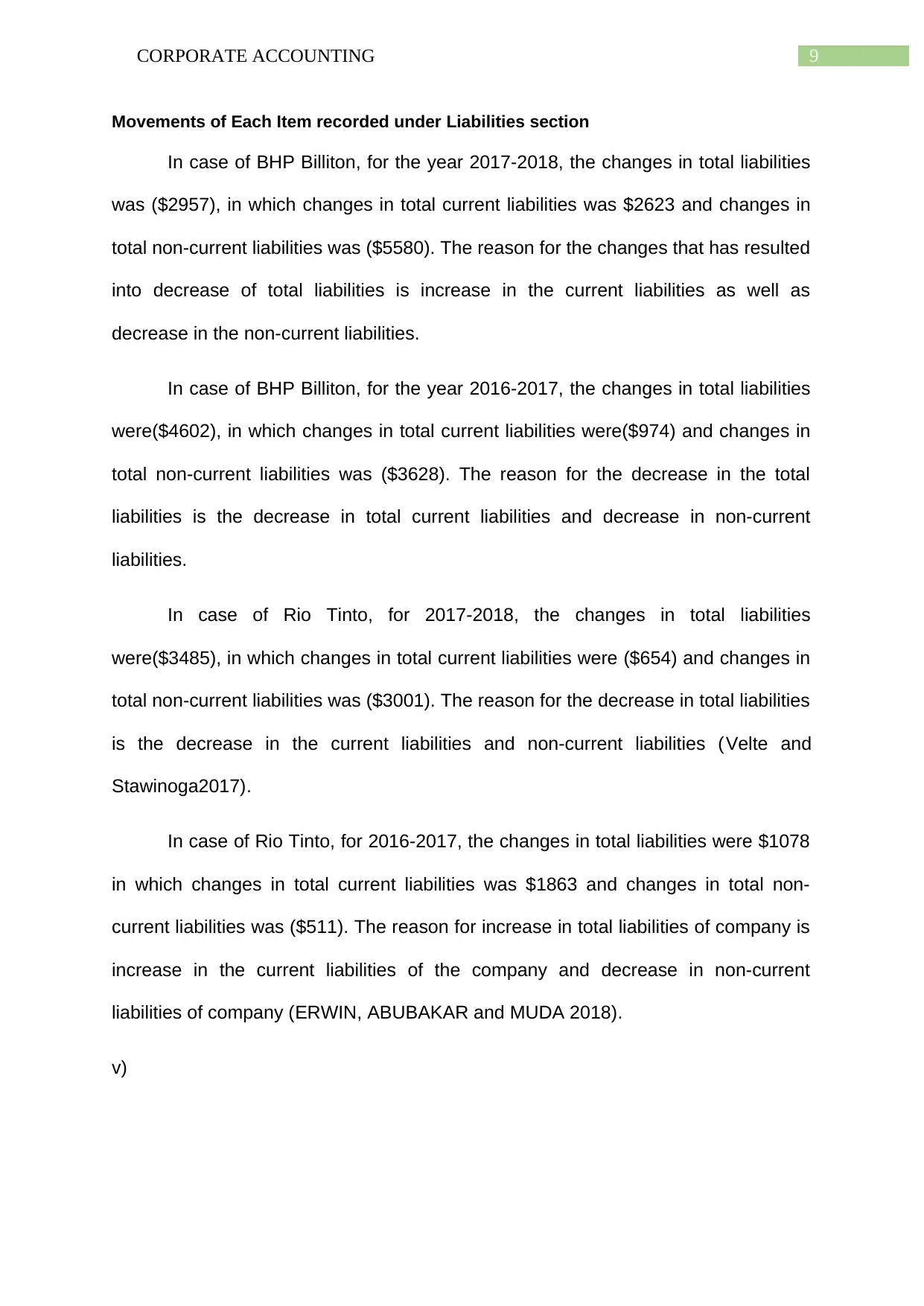
9CORPORATE ACCOUNTING
Movements of Each Item recorded under Liabilities section
In case of BHP Billiton, for the year 2017-2018, the changes in total liabilities
was ($2957), in which changes in total current liabilities was $2623 and changes in
total non-current liabilities was ($5580). The reason for the changes that has resulted
into decrease of total liabilities is increase in the current liabilities as well as
decrease in the non-current liabilities.
In case of BHP Billiton, for the year 2016-2017, the changes in total liabilities
were($4602), in which changes in total current liabilities were($974) and changes in
total non-current liabilities was ($3628). The reason for the decrease in the total
liabilities is the decrease in total current liabilities and decrease in non-current
liabilities.
In case of Rio Tinto, for 2017-2018, the changes in total liabilities
were($3485), in which changes in total current liabilities were ($654) and changes in
total non-current liabilities was ($3001). The reason for the decrease in total liabilities
is the decrease in the current liabilities and non-current liabilities (Velte and
Stawinoga2017).
In case of Rio Tinto, for 2016-2017, the changes in total liabilities were $1078
in which changes in total current liabilities was $1863 and changes in total non-
current liabilities was ($511). The reason for increase in total liabilities of company is
increase in the current liabilities of the company and decrease in non-current
liabilities of company (ERWIN, ABUBAKAR and MUDA 2018).
v)
Movements of Each Item recorded under Liabilities section
In case of BHP Billiton, for the year 2017-2018, the changes in total liabilities
was ($2957), in which changes in total current liabilities was $2623 and changes in
total non-current liabilities was ($5580). The reason for the changes that has resulted
into decrease of total liabilities is increase in the current liabilities as well as
decrease in the non-current liabilities.
In case of BHP Billiton, for the year 2016-2017, the changes in total liabilities
were($4602), in which changes in total current liabilities were($974) and changes in
total non-current liabilities was ($3628). The reason for the decrease in the total
liabilities is the decrease in total current liabilities and decrease in non-current
liabilities.
In case of Rio Tinto, for 2017-2018, the changes in total liabilities
were($3485), in which changes in total current liabilities were ($654) and changes in
total non-current liabilities was ($3001). The reason for the decrease in total liabilities
is the decrease in the current liabilities and non-current liabilities (Velte and
Stawinoga2017).
In case of Rio Tinto, for 2016-2017, the changes in total liabilities were $1078
in which changes in total current liabilities was $1863 and changes in total non-
current liabilities was ($511). The reason for increase in total liabilities of company is
increase in the current liabilities of the company and decrease in non-current
liabilities of company (ERWIN, ABUBAKAR and MUDA 2018).
v)
Paraphrase This Document
Need a fresh take? Get an instant paraphrase of this document with our AI Paraphraser
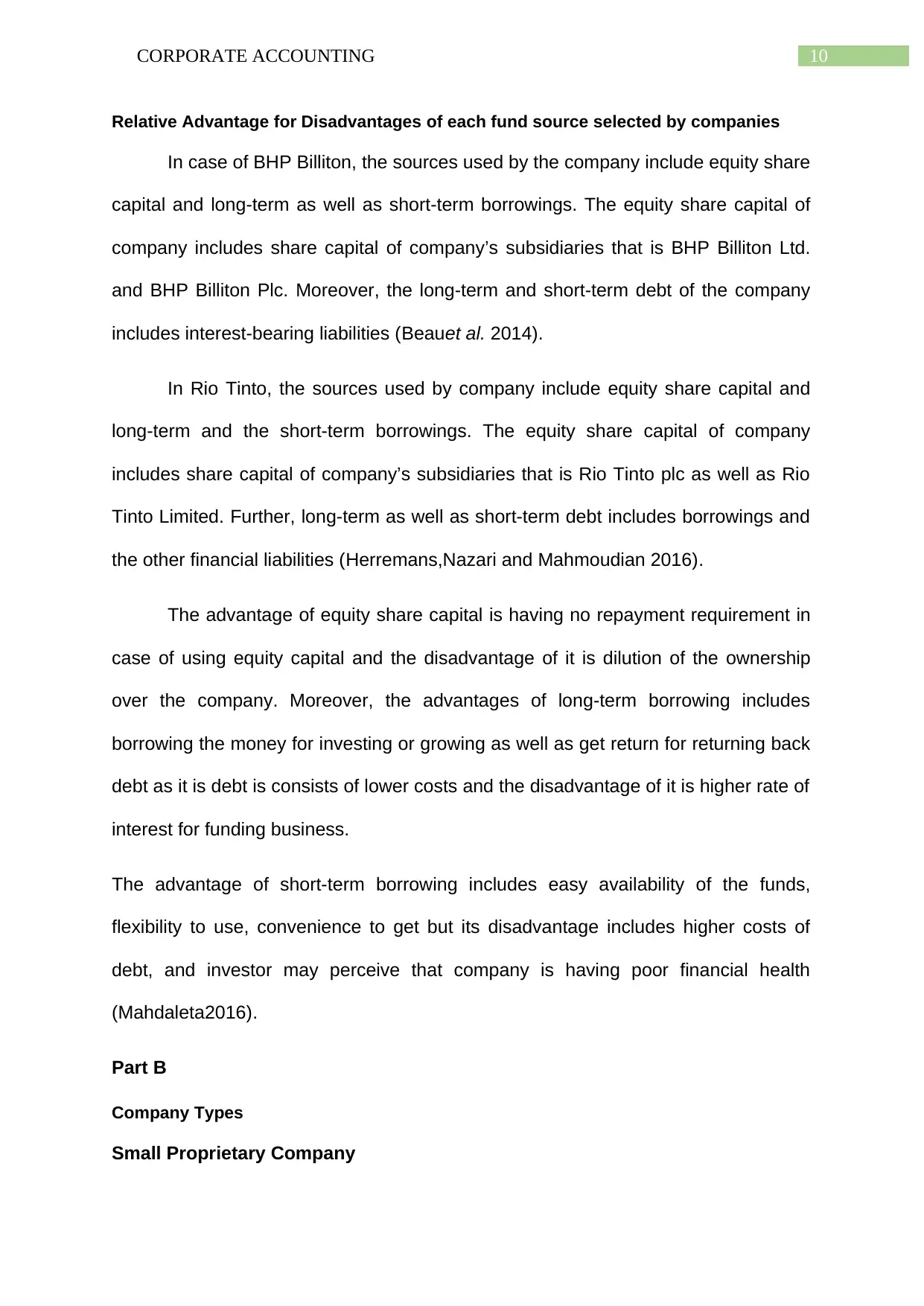
10CORPORATE ACCOUNTING
Relative Advantage for Disadvantages of each fund source selected by companies
In case of BHP Billiton, the sources used by the company include equity share
capital and long-term as well as short-term borrowings. The equity share capital of
company includes share capital of company’s subsidiaries that is BHP Billiton Ltd.
and BHP Billiton Plc. Moreover, the long-term and short-term debt of the company
includes interest-bearing liabilities (Beauet al. 2014).
In Rio Tinto, the sources used by company include equity share capital and
long-term and the short-term borrowings. The equity share capital of company
includes share capital of company’s subsidiaries that is Rio Tinto plc as well as Rio
Tinto Limited. Further, long-term as well as short-term debt includes borrowings and
the other financial liabilities (Herremans,Nazari and Mahmoudian 2016).
The advantage of equity share capital is having no repayment requirement in
case of using equity capital and the disadvantage of it is dilution of the ownership
over the company. Moreover, the advantages of long-term borrowing includes
borrowing the money for investing or growing as well as get return for returning back
debt as it is debt is consists of lower costs and the disadvantage of it is higher rate of
interest for funding business.
The advantage of short-term borrowing includes easy availability of the funds,
flexibility to use, convenience to get but its disadvantage includes higher costs of
debt, and investor may perceive that company is having poor financial health
(Mahdaleta2016).
Part B
Company Types
Small Proprietary Company
Relative Advantage for Disadvantages of each fund source selected by companies
In case of BHP Billiton, the sources used by the company include equity share
capital and long-term as well as short-term borrowings. The equity share capital of
company includes share capital of company’s subsidiaries that is BHP Billiton Ltd.
and BHP Billiton Plc. Moreover, the long-term and short-term debt of the company
includes interest-bearing liabilities (Beauet al. 2014).
In Rio Tinto, the sources used by company include equity share capital and
long-term and the short-term borrowings. The equity share capital of company
includes share capital of company’s subsidiaries that is Rio Tinto plc as well as Rio
Tinto Limited. Further, long-term as well as short-term debt includes borrowings and
the other financial liabilities (Herremans,Nazari and Mahmoudian 2016).
The advantage of equity share capital is having no repayment requirement in
case of using equity capital and the disadvantage of it is dilution of the ownership
over the company. Moreover, the advantages of long-term borrowing includes
borrowing the money for investing or growing as well as get return for returning back
debt as it is debt is consists of lower costs and the disadvantage of it is higher rate of
interest for funding business.
The advantage of short-term borrowing includes easy availability of the funds,
flexibility to use, convenience to get but its disadvantage includes higher costs of
debt, and investor may perceive that company is having poor financial health
(Mahdaleta2016).
Part B
Company Types
Small Proprietary Company
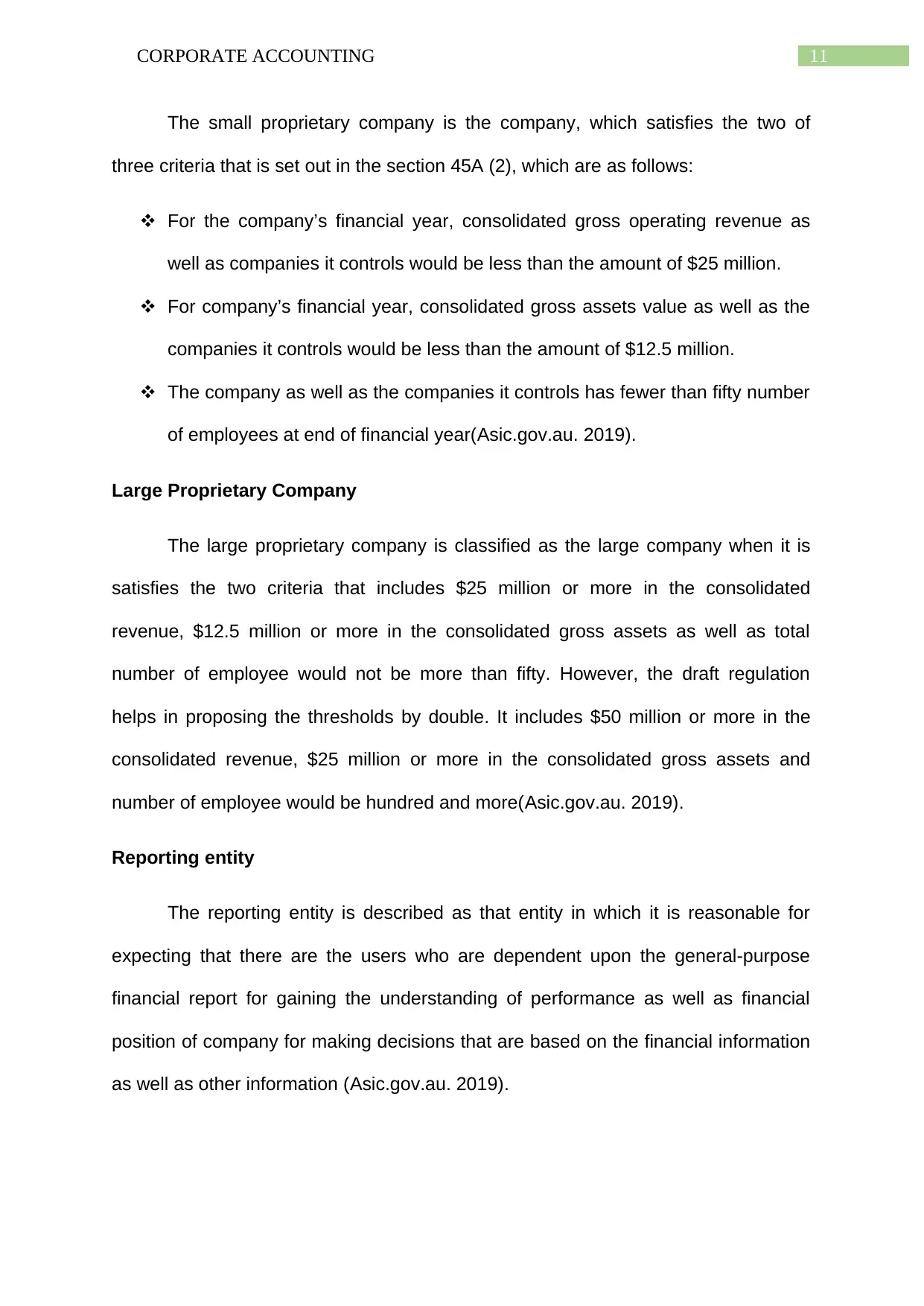
11CORPORATE ACCOUNTING
The small proprietary company is the company, which satisfies the two of
three criteria that is set out in the section 45A (2), which are as follows:
For the company’s financial year, consolidated gross operating revenue as
well as companies it controls would be less than the amount of $25 million.
For company’s financial year, consolidated gross assets value as well as the
companies it controls would be less than the amount of $12.5 million.
The company as well as the companies it controls has fewer than fifty number
of employees at end of financial year(Asic.gov.au. 2019).
Large Proprietary Company
The large proprietary company is classified as the large company when it is
satisfies the two criteria that includes $25 million or more in the consolidated
revenue, $12.5 million or more in the consolidated gross assets as well as total
number of employee would not be more than fifty. However, the draft regulation
helps in proposing the thresholds by double. It includes $50 million or more in the
consolidated revenue, $25 million or more in the consolidated gross assets and
number of employee would be hundred and more(Asic.gov.au. 2019).
Reporting entity
The reporting entity is described as that entity in which it is reasonable for
expecting that there are the users who are dependent upon the general-purpose
financial report for gaining the understanding of performance as well as financial
position of company for making decisions that are based on the financial information
as well as other information (Asic.gov.au. 2019).
The small proprietary company is the company, which satisfies the two of
three criteria that is set out in the section 45A (2), which are as follows:
For the company’s financial year, consolidated gross operating revenue as
well as companies it controls would be less than the amount of $25 million.
For company’s financial year, consolidated gross assets value as well as the
companies it controls would be less than the amount of $12.5 million.
The company as well as the companies it controls has fewer than fifty number
of employees at end of financial year(Asic.gov.au. 2019).
Large Proprietary Company
The large proprietary company is classified as the large company when it is
satisfies the two criteria that includes $25 million or more in the consolidated
revenue, $12.5 million or more in the consolidated gross assets as well as total
number of employee would not be more than fifty. However, the draft regulation
helps in proposing the thresholds by double. It includes $50 million or more in the
consolidated revenue, $25 million or more in the consolidated gross assets and
number of employee would be hundred and more(Asic.gov.au. 2019).
Reporting entity
The reporting entity is described as that entity in which it is reasonable for
expecting that there are the users who are dependent upon the general-purpose
financial report for gaining the understanding of performance as well as financial
position of company for making decisions that are based on the financial information
as well as other information (Asic.gov.au. 2019).
⊘ This is a preview!⊘
Do you want full access?
Subscribe today to unlock all pages.

Trusted by 1+ million students worldwide
1 out of 16
Related Documents
Your All-in-One AI-Powered Toolkit for Academic Success.
+13062052269
info@desklib.com
Available 24*7 on WhatsApp / Email
![[object Object]](/_next/static/media/star-bottom.7253800d.svg)
Unlock your academic potential
Copyright © 2020–2025 A2Z Services. All Rights Reserved. Developed and managed by ZUCOL.




